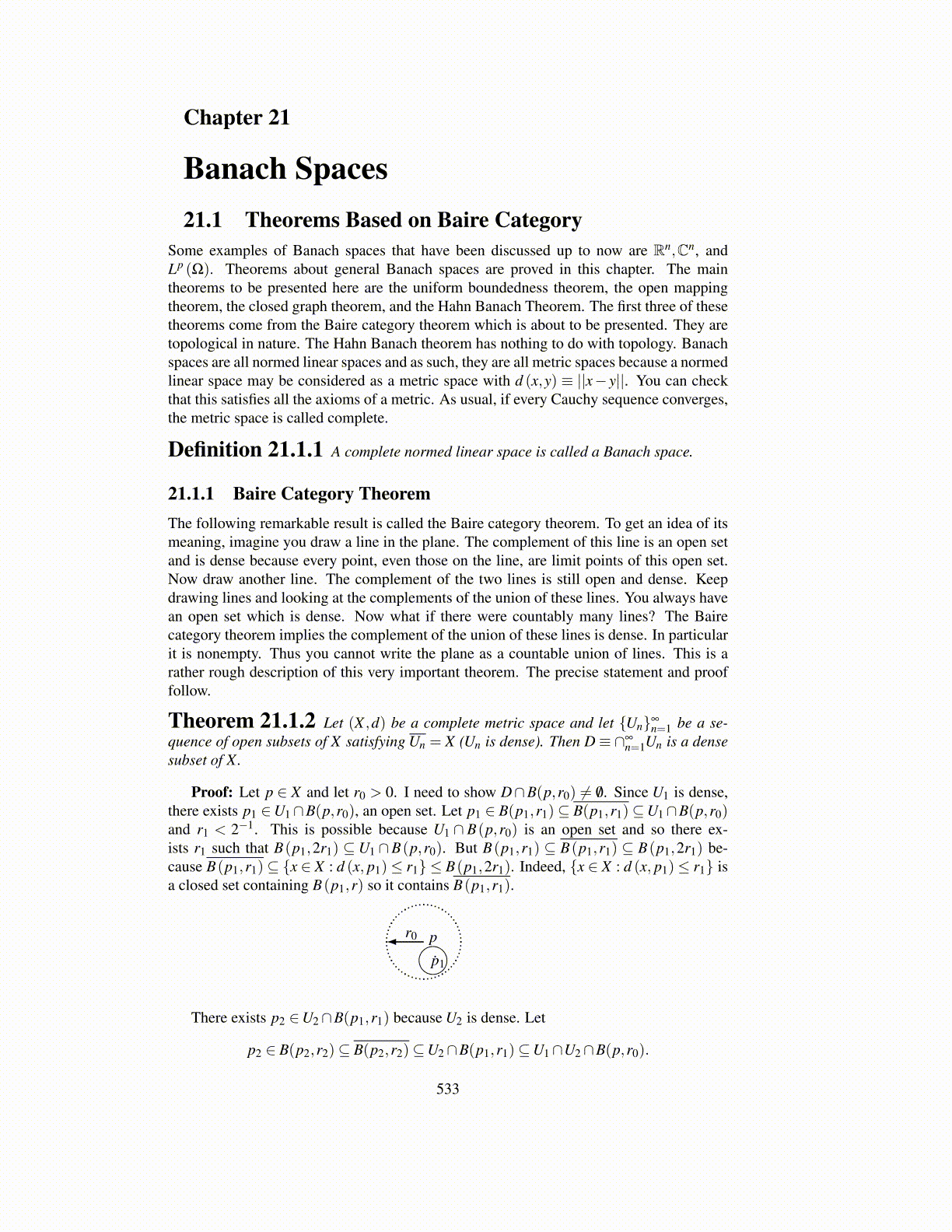
Chapter 21
Banach Spaces21.1 Theorems Based on Baire Category
Some examples of Banach spaces that have been discussed up to now are Rn,Cn, andLp (Ω). Theorems about general Banach spaces are proved in this chapter. The maintheorems to be presented here are the uniform boundedness theorem, the open mappingtheorem, the closed graph theorem, and the Hahn Banach Theorem. The first three of thesetheorems come from the Baire category theorem which is about to be presented. They aretopological in nature. The Hahn Banach theorem has nothing to do with topology. Banachspaces are all normed linear spaces and as such, they are all metric spaces because a normedlinear space may be considered as a metric space with d (x,y) ≡ ||x− y||. You can checkthat this satisfies all the axioms of a metric. As usual, if every Cauchy sequence converges,the metric space is called complete.
Definition 21.1.1 A complete normed linear space is called a Banach space.
21.1.1 Baire Category TheoremThe following remarkable result is called the Baire category theorem. To get an idea of itsmeaning, imagine you draw a line in the plane. The complement of this line is an open setand is dense because every point, even those on the line, are limit points of this open set.Now draw another line. The complement of the two lines is still open and dense. Keepdrawing lines and looking at the complements of the union of these lines. You always havean open set which is dense. Now what if there were countably many lines? The Bairecategory theorem implies the complement of the union of these lines is dense. In particularit is nonempty. Thus you cannot write the plane as a countable union of lines. This is arather rough description of this very important theorem. The precise statement and prooffollow.
Theorem 21.1.2 Let (X ,d) be a complete metric space and let {Un}∞n=1 be a se-
quence of open subsets of X satisfying Un = X (Un is dense). Then D≡ ∩∞n=1Un is a dense
subset of X.
Proof: Let p ∈ X and let r0 > 0. I need to show D∩B(p,r0) ̸= /0. Since U1 is dense,there exists p1 ∈U1∩B(p,r0), an open set. Let p1 ∈ B(p1,r1)⊆ B(p1,r1)⊆U1∩B(p,r0)and r1 < 2−1. This is possible because U1 ∩ B(p,r0) is an open set and so there ex-ists r1 such that B(p1,2r1) ⊆ U1 ∩B(p,r0). But B(p1,r1) ⊆ B(p1,r1) ⊆ B(p1,2r1) be-cause B(p1,r1)⊆ {x ∈ X : d (x, p1)≤ r1} ≤ B(p1,2r1). Indeed, {x ∈ X : d (x, p1)≤ r1} isa closed set containing B(p1,r) so it contains B(p1,r1).
r0 p
p1·
There exists p2 ∈U2∩B(p1,r1) because U2 is dense. Let
p2 ∈ B(p2,r2)⊆ B(p2,r2)⊆U2∩B(p1,r1)⊆U1∩U2∩B(p,r0).
533